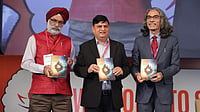Diesel generators have been touted as one of the prime contributors of air pollution in India. As per the National Clean Air Programme 2019, diesel generators account for up to 7-8 per cent of air pollution in some cities. In cognizance of the challenge, India has been undertaking several measures such as imposing restrictions on their use, enforcing stringent emission standards and recommending technological advancements that would help improve the overall efficiency of generators. Shveta Arya, Managing Director and head of Power Systems Business Unit, Cummins India, speaks to Outlook Planet, about the firm’s new generation of eco-friendly generators and how these could help reduce emissions.
Diesel generators typically emit carbon monoxide, hydrocarbon, nitrogen oxides and particulate matter, known contributors to air pollution. How do the new generation of gensets reduce these emissions?
The Central Pollution Control Board (CPCB) IV+ standards represent a pivotal shift for the Indian genset industry, spurring technological advancements. These gensets reduce emissions by incorporating advanced technologies like electronic fuel injection, after-treatment systems and optimised combustion processes. These innovations minimize pollutants, such as nitrogen oxides, particulate matter and hydrocarbons.
Electronic fuel injection, for instance, ensures precise fuel delivery, improving efficiency and reducing unburned hydrocarbons. Similarly, after-treatment systems (including catalytic converters and diesel particulate filters) capture harmful emissions before they are released into the air. Improved engine design further enhances combustion efficiency, leading to reduced emissions while maintaining performance, reliability, and fuel efficiency
They represent a significant step towards a greener, cleaner energy future.
Compared to older models, what kind of emission control technologies do the new gensets employ?
Over the past five years, our power systems team has been working meticulously on developing state-of-the-art genset engines that comply with the new emission standards set by the CPCB for diesel generator manufacturers in India. These machines have evolved from basic mechanical devices into advanced electronic systems featuring intelligent controls, cutting-edge exhaust treatment technologies, remote monitoring, and predictive maintenance capabilities.
The selective catalytic reduction (SCR) technology, for instance, plays a crucial role in lowering NOx emissions by injecting a urea-based solution into the exhaust to convert NOx into harmless nitrogen and water. Combined with optimised combustion and advanced turbocharging, these technologies ensure compliance with CPCB IV+ norms and drastically lower emissions compared to older models.
How would the new gensets compete with alternative energy efficient sources?
The CPCB IV+ compliant gensets won’t necessarily compete with alternate energy efficient sources but complement them. While renewable energy generation is key to lowering emissions, the power output from such sources is not always stable. Hence, we need to have a stable back-up power and this is where advanced gensets could play a major role. The new generation gensets are more fuel efficient than older models, achieving a lower carbon footprint at a relatively lower operational cost.
How do the technological upgrades help improve efficiency levels?
The most significant benefits of these advancements are enhanced pollution control, extended asset lifespan, and a substantial reduction in greenhouse gas emissions (GHGs). For example, the remote monitoring device enables real-time tracking of the genset’s operational parameters, allowing users to optimise performance, detect inefficiencies and address potential issues proactively. This reduces fuel wastage, ensures compliance with emission norms, and minimises downtime, thereby enhancing overall operational efficiency.
Can you elaborate on the merits of the dual fuel system and how they help in achieving efficiency?
The dual-fuel system prescribed by the Commission for Air Quality Management (CAQM) offers significant merits in reducing air pollution and achieving environmental sustainability. This system operates by using a combination of two fuels—typically a cleaner fuel like natural gas (CNG or LNG) and a conventional fuel such as diesel. The dual-fuel approach addresses pressing environmental concerns, especially in urban and industrial areas, by lowering emissions from combustion engines.
One of the key benefits of this system is that it can be applied to existing gensets, making it an effective retrofit solution. This adaptation allows older gensets to meet stricter emission standards without requiring complete replacement.
Given that power demand is expected to rise in the future, do you see a role for next-gen gensets help India achieve its energy security goals?
India’s power consumption has been growing rapidly, reaching 1,503.65 billion units (BU) in FY23 with an expected CAGR of over 6 per cent from 2022-2035. As India’s economy grows, the demand for reliable power is expected to rise significantly.
With the increasing need for power in sectors like manufacturing, healthcare, and transportation, these gensets provide a dependable backup, ensuring continuous operations even during grid outages. By enhancing power reliability and improving operational efficiency, these advanced gensets support India's broader goals of achieving energy security.

























